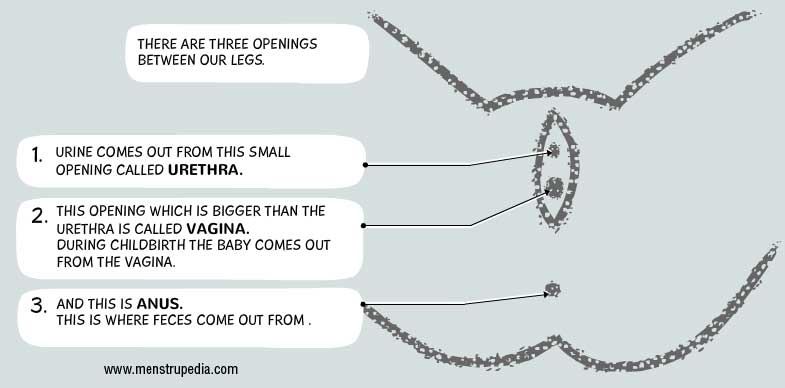Women love to talk. At least most women do. But we just don’t talk enough about our vulvas, vaginas, menstruation and reproduction. Most gynecological problems could be handled far more easily without the associated stigma or reluctance of being examined ‘down there’ if this were not the case.
One of my friends once said, “Men have functional, low maintenance bodies. Women, on the other hand, are blessed with grace, curves and complex contraptions to handle.” Isn’t it true? There is no simple answer to anything related to our reproductive organs!
So as a first step to embracing our complex but beautiful bodies, here are some things that every woman should know about.
- Anatomy 101:
Here’s an important fact to start with – women have 3 openings down there.
The first is the urethra. Women urinate from the urethra, which connects to the bladder. Women do NOT urinate from the vagina.
The second is the vagina. This is right below the urethra and is also the place where menstrual discharge and babies come out of and where the penis enters the female body during sexual intercourse. The vaginal canal is a deep, mysterious creature, with the ability to summon pleasure, pain and motherhood.The vaginal canal goes all the way up to the cervix. The cervix is like a roof for your vagina andhas a round, smooth feel, like the tip of your nose. This very cervix dilates to make way for a babyto come out during labor.
The third opening is the anus, all the way at the back, between the buttocks. This is of course the same for the sexes, and has the same function.
Now that we have the basics out of the way, let’s add some more layers.
The urethra and vagina are sensitive organs and are enclosed by the labia, which look like lips. For added protection to the area, we have two sets of labia, the outer and the inner labia. The inner labium meets at the top to form a little triangle, which is known as the clitoral hood. The clitoris is half outside and half internal, and looks like a little nub. A fun fact – the clitoris is the only organ in the body that is meant solely for sexual arousal!
All the parts that we can see outside (the outer and inner labia, urethra, clitoris, vagina) are collectively called the vulva.
- Keeping it clean:
Keeping the vulva clean is extremely important to ensure good reproductive health.
- The best way to clean the vaginal area is by using good old water. The vagina is naturally acidic andhas beneficial bacteria that keep infections away. Messing with the normal acidity levels is a bad idea. Avoid using any sort of soap, spray or cleanser on the vulva or inside the vagina, as this can cause irritation and infections.
- Do not rub the area; treat it with gentle pats and dabs. Avoid harsh towels and toilet paper;get soft wipes instead.Drink plenty of water and healthy fluids like coconut water to help the vagina produce discharge to clean itself.
- Wear breathable, cotton underwear as much as possible to keep rashes away.
- Take extra care of hygiene during menstruation – change your napkin/tampon frequently, or wear a menstrual cup.
- Always wipe yourself from front to back (from the vulva to the anus). This prevents transmission of fecal bacteria to the vulva.
- NEVER have unprotected sex with an unknown partner. Insist on a condom, even for oral sex. Get yourself and your partner tested for Sexually Transmitted Diseases (STDs) to be sure.
- Make it a habit to clean up after sexual intercourse. It is good to urinate after sex, to prevent Urinary Tract Infections (UTIs).

- SOS
Given below is an indicative list of irregularities that are warning signs and warrant a visit to the doctor.
Menstrual red flags:
- Periods less than 21 days apart or more than 45 days apart
- Severe abdominal or pelvic pain during menstruation
- Excessive menstrual bleeding (more than one pad/tampon per hour for several hours)
- Periods lasting longer than 7 days
- Bleeding or spotting between periods
Other irregularities:
- Abnormal vaginal discharge.
This can include:
- Heavy, yellow-green or gray vaginal discharge
- Thick, whitish-gray discharge, with a cottage cheese like texture
- Strong vaginal odor
- Discomfort or pain during sexual intercourse
- Itching or irritation around the vagina
- Pain, spotting, bleeding while urinating
How do you know when things are not normal down there? When should you go see a doctor?
To distinguish the usual from the unusual, make sure you regularly check your vulva, the color and consistency of your vaginal discharge and your menstrual cycle.
- Prevention is always better than cure!
Find a good gynecologist in the city you live in. Make sure you are comfortable with him/her.Always exercise FULL disclosure with your gynecologist.
Track your periods regularly. There are many free apps (on Android, iOS, Windows) to track them and to prompt you when they are due. Whichever method you adopt, it is critical to know the dates of your periods, so that you can immediately check on anything out of place. This is also useful information for when you visit your gynecologist.
Do not pop hormonal/birth control pills without prescription. If things go wrong during sex,exercise due caution before using emergency contraceptives. Frequent use of these pills can affect the reproductive system.
There are some tests mentioned below that should be conducted periodically by every woman. These help detect diseases well in time.
Pelvic exam and Pap smear:Screening should start in 3 years after having sexual intercourse, or by the age of 21 years. From then on, screening should be done every 2 years.These tests help in the detection of cervical cancer.
Breast examination:All women should do monthly breast self-examination. Any unnatural lump/growth should be reported to the gynecologist.
Mammograms:Every woman above 40 years of age should get a mammogram done annually to check for breast cancer.
There is absolutely no shame in understanding your private parts. Get familiar with your anatomy. Practice good hygiene and safe sex. Visit the doctor at least once a year. And most importantly, stay happy!
Saini is currently finding her feet at Saral Designs, a social enterprise that designs product-driven solutions to solve critical problems in the field of menstruation, hygiene and sanitation. She loves travel, food and the company of books. She lives in Bombay, and is always free for a coffee in Madras Café, or shopping for trinkets at Colaba Causeway.
Editor: Divya Rosaline









